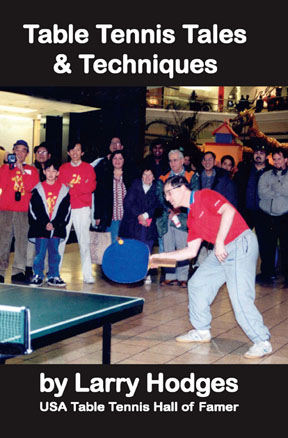 Table Tennis Tales & Techniques
Table Tennis Tales & TechniquesThe Best of Larry Hodges!
 Table Tennis Tales & Techniques
Table Tennis Tales & TechniquesA Review
Larry Hodges’ Table Tennis Tales & Techniques
By Tim Boggan
Larry Hodges' new book, Table Tennis Tales & Techniques (retails for $19.95; available from all leading t.t. distributors), is characterized, a la Lewis Carroll, by both logic and whimsy. Successful at being both instructive and entertaining, the book, enhanced by a good number of photos, starts off with an inventive, not to say wacky, 30-page varied section called "Humor," then switches ends to more than 20 informative pages on Ten-Point Plans to Serving and Rallying Success. Hence the reader moves from 12 Reasons Why Sponge is Better than Hard Rubber ("Pimpled rubber baths hurt and leave abrasions on the skin"); to Jim McQueen being forced in a match by umpire Cyril Lederman to take off his warm-up pants, and, having set Cyril up, goes him one better by first stripping off his playing shorts, then (gasp) his underwear, until…he's finally ready to play in a very skimpy something certainly covering something. Continuing on, you see that, despite his own "lifetime weakness" of not relaxing his arm when stroking, Coach of the (you name it) Year Hodges favors the light touch. That is, he uses both colloquial directives ("Don't just stand there after serving—follow your plan!") and conversational rhetoric ("How do you make a no-spin serve look like it has spin? It's all where you contact the ball.")
"Chess at hyper speed"—that's table tennis. So after those strategically-placed high-toss serves, better develop your follow-up strokes and footwork, and, as a necessary back-up, your counter-loops and lobs. With Larry's help, you won't fear combination rackets, and with a clarity that bespeaks clarity Larry advises, "If you cannot attack well under pressure, the only way to learn to do so is to attack under pressure." But even as Larry is serious—talking about deceptive techniques, for example—he looks to amuse. In discussing the "causes of B.O.," he says "the root of the problem is feet." If you don't want to be Backhand-Oriented, you must start with "feet placement." He tells you about playing choppers, but he doesn't like "Chiseling" and so offers "A Trick to Beat a Tricky Pusher." He does like to do exhibitions, though—and with all kinds of paddles (or non-paddles) and in all kinds of positions.
Halfway through the book, Larry goes into hiding. Once there was a hostage crisis at the Sands Hotel in Las Vegas, and, as befitting one who's written "1100 articles in 83 different publications," Larry, hiding under poker tables amid terrorized guests," is scribbling away furiously to give us the villainous tale, and with it, even photos of the later implosion of the hotel to make room for another, today's Venetian. Want the Hodges' TV and Movie Guide? The Gary Shandling Show's take-off on the baseball movie "The Natural" gets a top 5 Paddles in all three categories—while in Movieland "You Can't Cheat an Honest Man," a W.C. Fields 1939 film, wins 5-4 over "Forrest Gump," but only in Table Tennis Quality, presumably because of Fields' backhand technique that with a formidable back slap dislodges a ball stuck in a wide-eyed matron's mouth.
One of Larry's degrees is in Math, so if he proves via Einstein's Relativity Theory that Olympic and World Champion Liu Guoliang can counter-smash at 279,380,000 mph, could you or your shadow-practicing practice partner disprove it? And what about the "Inside-Out Forehand Floppy Wrist Flip"—can you learn to say it before you learn to do it? Larry's not only skillful in showing in various ways how to fake-out an opponent, but he can't resist playfully trying to do the same with a reader. Read his review of the latest Chinese technology—the Loo Fuoy 1.4 Table Tennis Robot—and you might not be able to tell, even from the April fool title, it's a put-on.
"Always Have Something Ready at the End" is Hodges' close-match advice. And in these packed pages he moves to his end-game finish with pages and pages of "They Said It!" quirkiness—quotes not made-up by Larry but, because found interesting, long-collected by him. Some reflect high seriousness ("'If the shipment was just ping-pong balls, tell us.' An unidentified senior State Department official, on reports that China had shipped missile parts to Pakistan, Newsweek, September 6, 1993, page 28"). Some seem high comedy—like what security guards learn at major tournaments ("I should have entered the tournament. I have a nasty serve, and I think I'd have a good chance of winning the whole thing."…They [table tennis players] put this glue on to make the paddle stick to their hands. But we are not supposed to let them put it on in the building"). Some are in between ("'Wouldn't it be great if we could hold a big table tennis match, with a basketball exhibition at halftime?' Ty Hoff").
These cumulative quotes are followed by a final, couldn't-be-more-serious winner—a "USATT Junior Training Proposal" that explains to the USOC how we can eventually win medals.
The value of this book can be seen not only in Larry's encyclopedic knowledge of professional techniques, but in his intense yet uniquely imaginative approach to coaching. His great strength is: he's not afraid to be himself—that is, different. Mirroring his passion for writing, for creating, Tales and Techniques shows an original mind proving that an absorption in Table Tennis can, for everyone, be FUN!